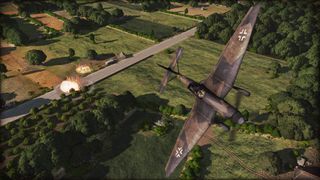World War 2 is familiar ground for drama, but it’s for a good reason. Unlike so many other regional conflicts, World War 2 was the last time we saw entire continents engaged in an all-out war effort, their populations mobilized, and their existence on the line.
For Steel Division, the unpredictable and unstable nature of real-life history gave developer Eugen Systems provided the perfect backdrop for the campaign’s missions. They’re more than a good inspiration, though. Steel Division’s campaign follows historical records closely, and these lesser-known snippets of real history are just as interesting as anything you’ve seen in other games of on the big screen. Here’s the real history behind Steel Division’s campaign missions.

Mission Boston
In Steel Division’s first campaign, you play as Shields Warren, a commander in the 508th Parachute Infantry Division in the morning hours of D-Day. You battle through thick mazes of hedgerows, capture bridges, and secure the coastal towns in Normandy ahead of the amphibious invasion forces.
In real life, Shields Warren parachuted into France with the 508th as part of the 82nd Airborne Division. The 82nd’s job was to block off Route N13, a major roadway and Germany's best avenue to launch a counteroffensive. To do this, they had to capture the town of Sainte-Mère-Église and crossings over the Merderet river. Parts of the 508th, 507th, and 505th were scattered across incorrect landing zones, so they improvised combined units and started fighting. They captured their objectives and held them in the face of German counter-attacks until reinforced by tanks driven inland from the beaches.
Sainte-Mère-Église became known as the first town in France to be liberated from Nazi control—something that made such an impact on the town that the official heraldry was changed to add two bright stars dangling from parachutes. Famously, paratrooper John Steele got caught on the church steeple and was stuck hanging above the town square in Sainte-Mère-Église for several hours. This experience has become part of the town's mythology; a model of Private Steele still hangs from the church roof today. That church's stained glass windows also feature an image of the Virgin Mary watching over paratroopers as they land.

Atlantikwall
In real life, Hitler and Rommel were famously unavailable on the morning of the Normandy invasion, and their standing orders still assumed that the real invasion was imminent at a different part of the continent. The 21st Panzer Division was stationed closest to the invasion, outside of the landing zones designated Sword and Juno. They struggled to reach German central command to change their orders, and it wasn’t until late on D-Day that they launched the only armored counterattack against the allies. After suffering significant casualties, the 21st called off their counter-attack and retreated.
In Steel Division’s second campaign, the developers ask: what if those orders hadn’t been so slow to come? What if orders had arrived on time, and the 21st Panzer Division lead the charge against the Normandy invasion? Even when the game ponders alternate histories, the path of the 21st is the same as in real life, pushing North toward Juno Beach over the now-infamous Pegasus Bridge.

Operation Epsom
In Steel Division, Operation Epsom is the most difficult and brutal campaign set available. As Sir Colin Muir Barber, players command the 15th Scottish Division in an assault on Hill 112, a strategic vantagepoint overlooking Caen, France.
After the shock, drama, and surprise of the invasion, it’s easy to forget that the Allied march to Berlin took place an inch at a time, fought out in a long, bloody grind. Three weeks after D-Day, the 15th Scottish Infantry Division began Operation Epsom, the final phase in the fight to seize the occupied French city of Caen. As the allies advanced from the Normandy beaches, Caen was the first major urban center in their path to Paris. Seizing it was a key part of the Allied strategy--and the Germans knew it. The Nazis’ all-out defensive struggle slowed the Allied advance to a crawl, but it cost the Germans dearly. Even German forces intended for counter-attacks in other parts of the countryside were redirected against the 15th in an all-out attempt to hold Caen.
In the end, the real Operation Epsom eventually ended in a tie, more or less. Out of men and resources, the Germans fell back to form a new defensive line on the Seine river. The Allies forces were also exhausted, and they fell back to form the reserve force while newly arrived army groups took over the front-line assault. The real-life Colin Muir Barber commanded the 15th Scottish Infantry as they led the charge across the Seine, Rhine, and Elbe rivers and into Berlin.
The biggest gaming news, reviews and hardware deals
Keep up to date with the most important stories and the best deals, as picked by the PC Gamer team.
